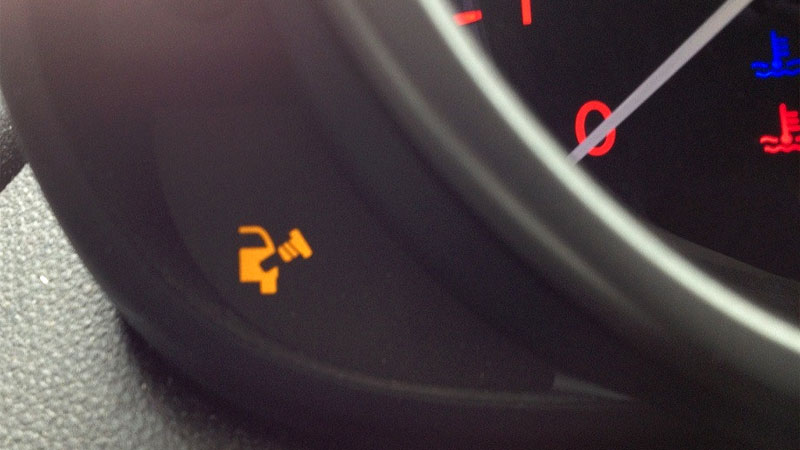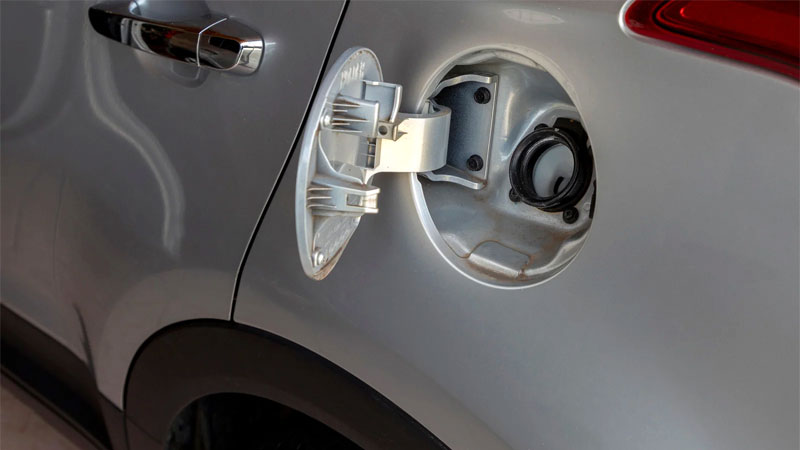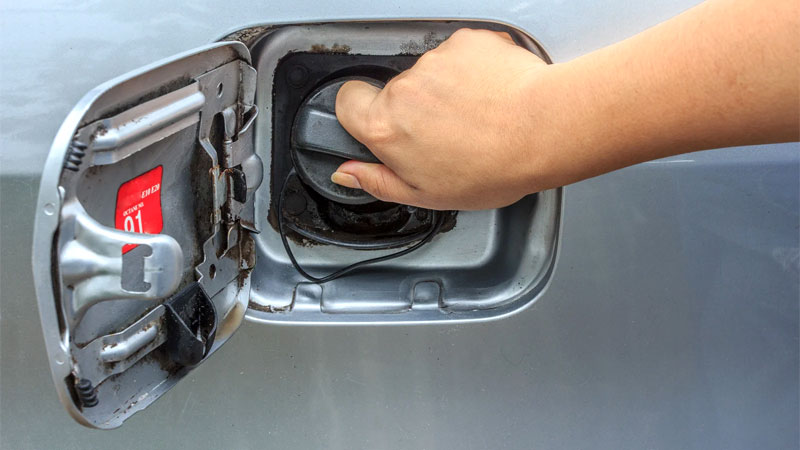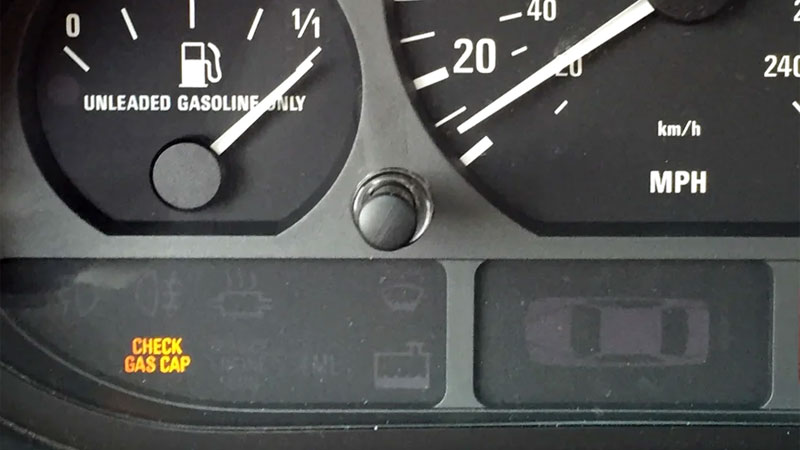When you get gas, it’s important to screw the fuel cap on all way way and make sure it’s tight. If you don’t, you are likely to see a check engine light soon after you drive away from the gas station.
In addition to a check engine light, some vehicles have a “check fuel cap” or “check gas cap” light. This light turns on when a problem is detected with the EVAP system in your vehicle.
While a “check fuel cap” message sounds self explanatory, there is one instance where the root cause of the problem is not the gas cap itself. Read on to learn more about this common issue and how to clear this warning light.
What Does “Check Fuel Cap” Mean?
“Check Fuel Cap” is a convenient message to the driver that indicates the likely cause of the check engine light that just popped up on the dash. This helps the driver narrow down the cause of the check engine light without needing to scan a code.
In some cases, a fuel cap symbol (shown below) may appear in place of text.

Common Causes of “Check Fuel Cap” Warning
The diagnostic steps to find the root cause of your Check Gas Cap warning light are fairly straightforward. Here are the most likely causes.
1) Missing Gas Cap
A missing gas cap is the #1 cause of this warning light illuminating, and the fix is really simple. Just put the gas cap back and off you go.
It’s easy to forget your gas cap when you’re filling the tank. If you live in a state where you have gas station attendants, these attendants have to service many vehicles at the same time and could easily forget when the gas station gets busy.
It’s usually worth it to drive back to the gas station that you last fueled up at (if it’s within a reasonable distance. The cap may have been turned it to the gas attendant by another motorist or it may even be laying in the same spot it was accidentally left at.

2) Bad Fuel Cap Gasket (or Bad Gas Cap)
If your fuel cap is old, it might be time to simply replace it. As your gas cap ages, the gasket that seals the tank may break down and allow fuel vapors to escape.
Your vehicle would detect this pressure differential in the fuel tank and throw a check engine light (in addition to the “check fuel cap” message).
3) Loose Fuel Cap
A loose fuel cap is harder to detect because it looks like your cap bas been replaced. To check for a loose fuel cap, make sure you tighten the cap until you hear a click. Some fuel caps will ratchet, allowing you to click the cap multiple times. One click should be plenty.
Sometimes you may need to remove the cap completely and retighten just to make sure the gas cap is threaded onto the tank correctly. Do this if you’ve tried to tighten the fuel cap and the warning light persists.

4) Leak in the EVAP System
A leak in the EVAP system is less fun to troubleshoot, but it is the likely cause of your check engine light if you have replaced the gas cap and still have a warning light. Parts of the EVAP system sit around the fuel tank but also in the engine bay, since the captured fuel vapors are routed into the intake for combustion.
Leaks in the EVAP system may originate from a bad hose, the purge valve, or the charcoal canister.
Sometimes you can smell fuel vapors near the source of the EVAP leak. Check for a gasoline smell under the hood or near the gas tank and you may be able to narrow it down.
What Happens When You Have an EVAP Leak?
Gasoline evaporates when it is exposed to air. This requires fuel systems to be sealed to contain the vapors so they cannot escape.
The purpose of the EVAP system is to capture and recirculate these fuel vapors within the fuel system. Once the vapors are captured, they are moved through a purge valve back to the intake manifold. These vapors then make their way into the combustion chamber with the rest of the atomized fuel from the fuel injectors.
When you have an EVAP leak, gasoline will slowly evaporate out of the fuel system. This is both harmful for the environment and reduces your vehicle’s fuel efficiency.
How to Reset a “Check Gas Cap” Light

Here are some simple steps you can follow to eliminate the gas cap as a possible cause of your warning light.
1) Turn Off Engine
The engine computer likely won’t retest the EVAP system while the vehicle is running, so you’ll have to turn the car off while troubleshooting. It’s also safer to turn the car off when you’re opening the gas tank anyway.
2) Unscrew the Fuel Cap
Remove the fuel cap completely and start over. That way you can make sure the cap is threaded on correctly.
3) Inspect the Fuel Cap
Check the underside of the gas cap to make sure the gasket is in good shape. Look for any flaws or excessive play in the fuel cap that could allow air to escape the tank.
4) Tighten the Fuel Cap Completely
Thread the fuel cap onto the gas tank and tighten until you hear a click.
5) Recheck for the Warning Light
If you want to check to see if the light returned, you’ll have to turn the car back on. The vehicle will run its EVAP test which may require you to drive around for a bit. If the Check Fuel Cap light does not return, then congratulations; you fixed your car!
Can You Drive With the Check Fuel Cap Warning?
Although you can drive with the Check Fuel Cap warning illuminated, it is advised that you do not do so any longer than is necessary to reach your immediate destination. Continuing to drive with a leaking EVAP system is harmful to the environment.
Additionally, it will cost you money in reduced fuel efficiency over time. If you live in an area that performs smog tests, this light will make you fail the test.
Recap
It’s important to make sure you understand any warning light you see on the dash. If you notice an unfamiliar light on the dash, check the owner’s manual for your vehicle. If you bought your vehicle used and it did not come with the manual, you can typically find a copy of the owner’s manual online.
Once you’ve addressed the Check Fuel Cap light, you’re good to go. The light shouldn’t come back unless a new leak is discovered.
If the light does come back after screwing the gas cap back on tightly, the root cause of your light is some other problem with the EVAP system. You may want to visit a mechanic to have them check your fuel system, and to ensure you don’t also have a fuel leak.

